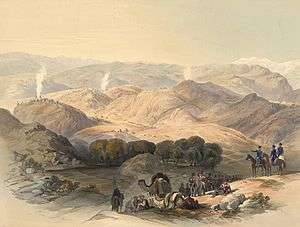William George Keith Elphinstone
Major-General William George Keith Elphinstone CB (26 January 1786 – 23 April 1842) was an officer of the British Army during the 19th century.
William George Keith Elphinstone | |
|---|---|
Major-General William Elphinstone (1836-1839) | |
| Born | 26 January 1786[1] Scotland |
| Died | 23 April 1842 (aged 56) Afghanistan |
| Service/ | British Army |
| Years of service | 1804–1842 |
| Rank | Major-General |
| Commands held | 33rd Regiment of Foot Kabul garrison |
| Battles/wars | Napoleonic Wars First Anglo-Afghan War |
Biography
He was born in Scotland in 1786, the son of William Fullerton Elphinstone, who was a director of the British East India Company, and his wife, Elizabeth Fullerton. His uncle was Admiral George Keith Elphinstone, 1st Viscount Keith.
Elphinstone entered the British Army in 1804 as a lieutenant; he saw service throughout the Napoleonic Wars, rising to the rank of lieutenant-colonel by 1813, when he became commander of the 33rd Regiment of Foot, which he led at the Battle of Waterloo in 1815. For his actions at Waterloo, Elphinstone was made a Companion of the Bath, as well as a knight of the Dutch Order of William and of the Russian Order of St. Anna 2nd class (6/18 August 1815)[2]. He left the regiment in 1822.[3] After Elphinstone was promoted to colonel in 1825, he served for a time as aide-de-camp to King George IV.

Elphinstone was promoted to major-general in 1837, and, in 1841, during the First Anglo-Afghan War, placed in command of the British garrison in Kabul, Afghanistan, numbering around 4,500 troops, of whom 690 were European and the rest Indian.[4] The garrison also included 12,000 civilians, including soldiers' families and camp followers. He was elderly, indecisive, weak, and unwell, and proved himself utterly incompetent for the post. His entire command was massacred during the British retreat from Kabul during January 1842.[5]
Elphinstone died as a captive in Afghanistan some months later. His body was dispatched with a small guard of Afghan soldiers to the British garrison at Jalalabad. Elphinstone's "faithful" batman Moore who had stayed with the General accompanied the body. En route, they were attacked by a "band of tribesmen", but eventually the body reached the garrison. Elphinstone is buried in an unmarked grave.[6]
See also
Notes
Citations
- London, England, Church of England Baptisms, Marriages and Burials, 1538–1812
- Список кавалерам Императорских Российских орденов всех наименований за 1832 год. Часть 3. Санкт-Петербург при Императорской Академии Наук. 1833, с. 133.
- Norris, James A. (1967). First Afghan War: 1838-42. Cambridge University Press. p. 337. ISBN 9780-5-2105-8-384.
- First Afghan War - Battle of Kabul and Retreat to Gandamak
- Macrory (1972), pp.267
- Macrory (1972), pp.261-262
References
- Stephen, Leslie, ed. (1889). . Dictionary of National Biography. 17. London: Smith, Elder & Co.
- Macrory, Patrick. 1972. Signal Catastrophe: The Story of the Disastrous Retreat from Kabul 1842. Book Club Associates, London.
- Macrory, Patrick. 2002. Retreat from Kabul: The Catastrophic British Defeat in Afghanistan, 1842. The Lyons Press, Guilford, Connecticut. ISBN 978-1-59921-177-0